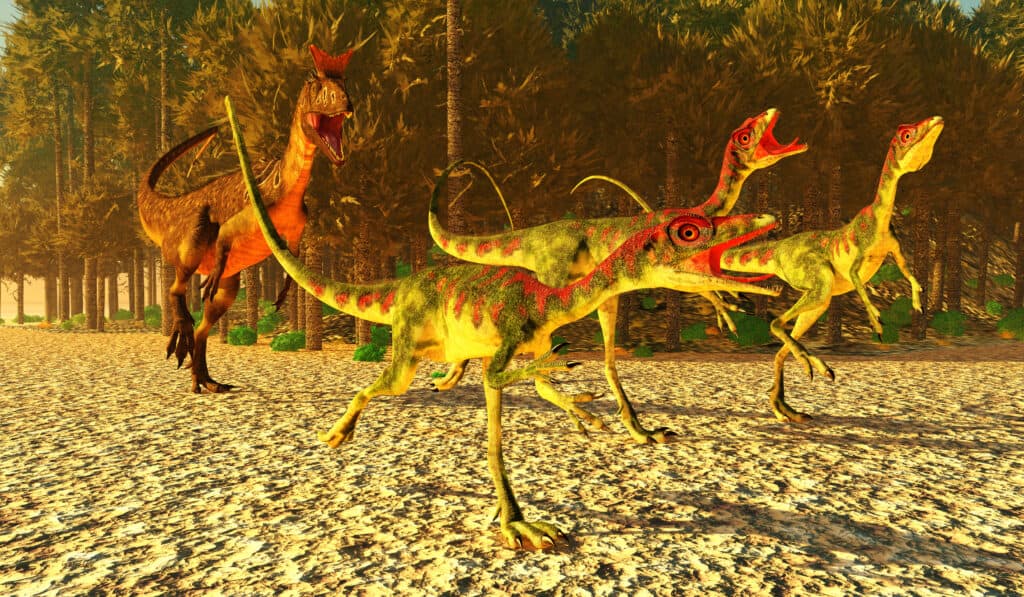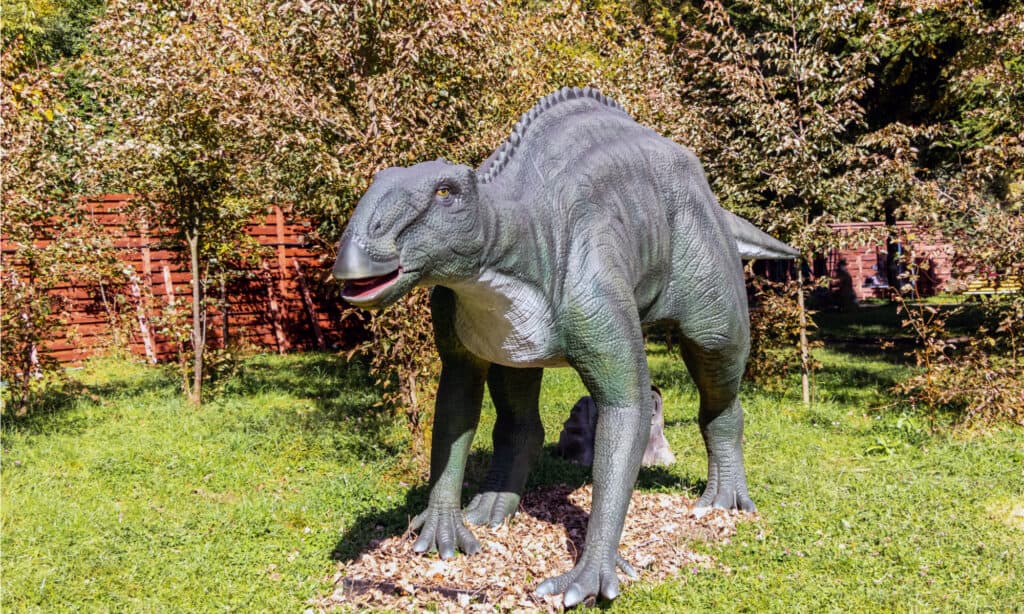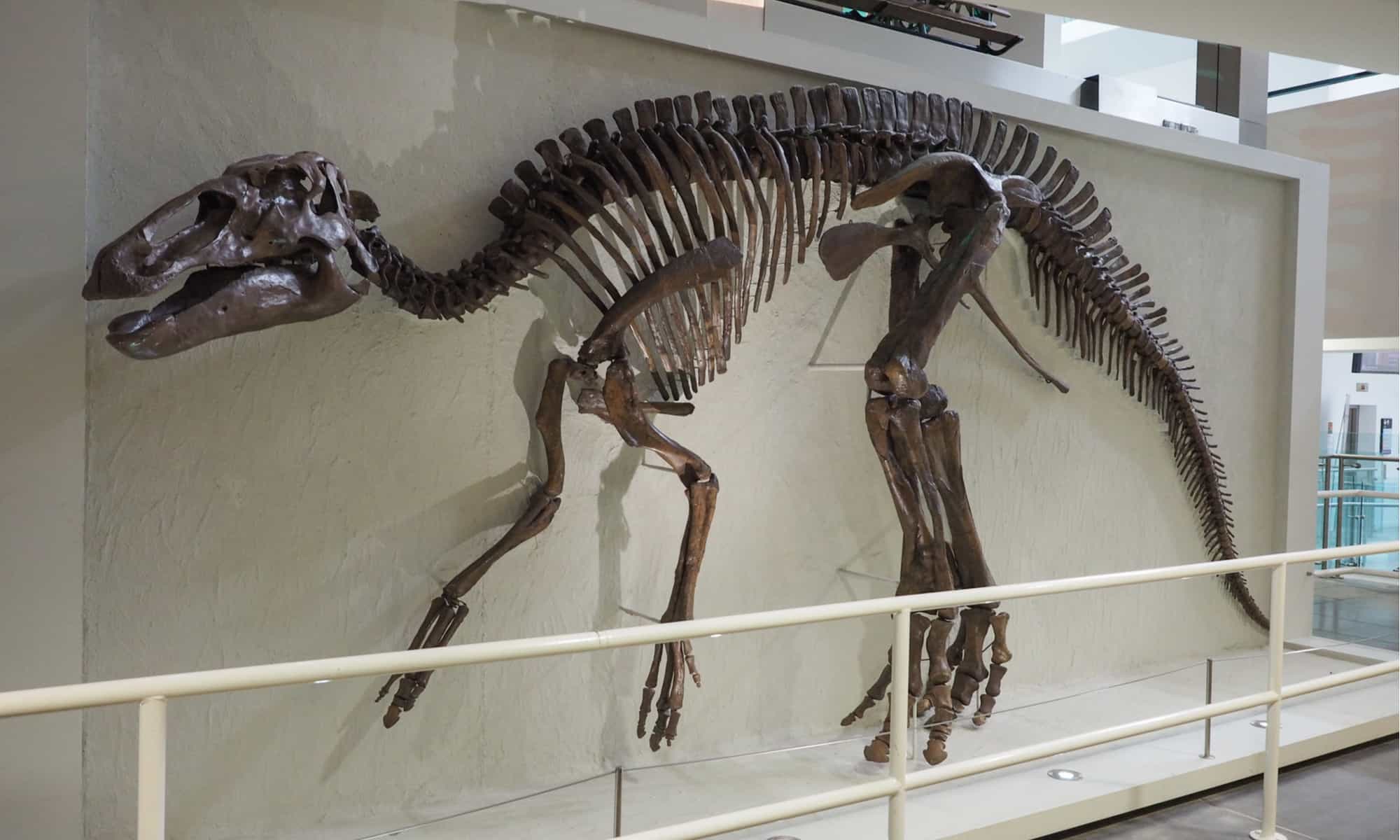Tennessee is considered among experts to be one of the best sources of North American fossils dating to the Early Devonian. This is because a shallow sea covered the state’s region during the Paleozoic period. Then, it was a swamp during the Carboniferous period.
Unfortunately for the topic at hand, the state lacks a rock record for the Permian and Jurassic periods. The following Cretaceous period had the western part of Tennessee underwater again. However, actual dinosaurs are known to have roamed the fields of the state. Mainly reaching the eastern part (in the west, life was represented mainly by sea turtles and the famous Mosasaurs).
When Did Dinosaurs Live In Tennessee?

Dinosaurs lived in Tennessee during the Mesozoic period.
©iStock.com/CoreyFord
Dinosaurs lived in Tennessee during the Mesozoic period. It is worth noting, however, that the early part of this period doesn’t have a clear rock record within the state. The sedimentation of fossils began only during the Cretaceous.
The Cretaceous period spanned about 79 million years, from 145 to 66 million years ago. It is the final and longest period of the Mesozoic. This culminates with the mass extinction event that eliminated dinosaurs from the Earth.
During that period, hadrosaurs could be found in the prehistoric region of Tennessee. Specifically found in the eastern part of the state, known to be dry and thus livable land.
Dinosaurs That Lived In Tennessee
The family of dinosaurs that lived in Tennessee is the Hadrosaurids, better known by their scientific name, Hadrosauridae. Part of the Ornithischia order, these dinosaurs are known as duck-billed due to their snouts featuring a flat, duck-bill appearance. They did not, however, have a bill; their bones were shaped like one.
From the family of hadrosaurids, the fossils of a single genus were discovered in the state – those of Edmontosaurus. In the following lines, we’ll take a closer look at the large Hadrosauridae family. Then review the genus whose presence is supported by fossil discovery.
Hadrosaurids

Hadrosaurids are the direct descendants of the
iguanodontiandinosaurs, like the one seen here.
©rodos studio FERHAT CINAR/Shutterstock.com
The scientific term Hadrosauridae can be translated as “stout or thick lizard.” The term refers mainly to the build of the species included in this family. Hadrosaurids are known as an essential part of the Ornithopoda clade of bipedal running grazers. However, unlike most members of this clade, hadrosaurids are now known to have been able to walk on four legs but also change to bipedal movement whenever needed or necessary (most likely mainly while feeding, to reach tall plants and branches easier) – as a result, these dinosaurs are known as facultative bipeds.
Hadrosaurids are the direct descendants of the iguanodontian dinosaurs, made famous by one of their representatives, the Iguanodon. The latter was a rather large herbivore that could grow up to 30-36 feet (9-11 m) long and weigh about five short tons (4.5 metric tons).
The type of species of the Hadrosauridae family is Hadrosaurus foulkii. It could grow up to 23-26 feet (7-8 m) long and weigh about 2.2-4.4 short tons (2-4 metric tons).
The Hadrosauridae family splits into the Hadrosaurus genus and the Saurolophidae subgroup. The subgroup splits into Lambeosaurinae and Saurolophinae, the latter including the genus whose fossils are the only unearthed dinosaur remnants in Tennessee – Edmontosaurus.
Edmontosaurus

E
dmontosauruscontains two known species –
E. regalisand
E. annectens.
©MVolodymyr/Shutterstock.com
The name of this genus can be translated as “lizard from Edmonton.” Tt was initially discovered in southern Alberta (with Edmonton as the capital city), specifically in the Horseshoe Canyon Formation. Edmontosaurus contains two known species – E. regalis and E. annectens. Both lived during the Late Cretaceous period, mainly between the Campanian and the Maastrichtian, about 73 to 66 million years ago. Edmontosaurus had a relatively short temporal range compared to other, better-known dinosaurs.
This dinosaur is one of the last that can be classified as non-avian. To clarify, avian dinosaurs are still alive today in the form of common birds, and they descend from the Theropoda clade, while non-avian dinosaurs are entirely extinct.
Edmontosaurus was contemporary with other famous dinosaur genera such as Ankylosaurus, Triceratops, and Tyrannosaurus.
The genus is important to the fossil history of Tennessee, as Edmontosaurus specimens were some of the largest representatives of the Hadrosauridae family. E. annectens, one of the two species included in the genus (but not its type species), could grow up to 39 feet (12 m) long and weigh about 6.2 short tons (5.6 metric tons).
Unlike most hadrosaurids, Edmontosaurus lived up to the name of its ancestor, the Iguanodon, being larger than the latter.
Why Is It Rare To Find A Dinosaur Fossil In Tennessee?
Dinosaur fossils are a rare find in Tennessee, as this is one of the states that were partially submerged underwater during the temporal range of the dinosaurs. As a result, most of the sediments that would preserve fossils for us humans to find have eroded instead of being deposited on lakes and sea beds.
Other fossils found in the state, such as Plesiosaur and Mosasaur fossils, are equally interesting, but one must note the fact that these are not dinosaur fossils.
Mosasaurs and plesiosaurs were marine reptiles that were part of the Reptilia class of prehistoric animals. For a prehistoric animal to be called a dinosaur, it should have had upright limbs and lived specifically on land during the Mesozoic Era (about 252 to 66 million years ago).
While many articles might talk of dinosaurs and mention giant sea turtles, mosasaurs, and even pterodactyls, keep in mind that those are not part of the Dinosauria clade.
Where To See Fossils Today In Tennessee
In Tennessee, fossils can be seen in one of the state’s four natural history museums – the Frank H. McClung Museum of Knoxville, the Gray Fossil Museum of Gray, the Middle Tennessee Museum of Natural History of Murfreesboro, and the Pink Palace Museum and Planetarium of Memphis, as well as in the Tennessee State Museum.
The Tennessee State Museum is probably the best way to see fossils if you’re just visiting the state. While it doesn’t feature any dinosaur fossils, it is well-known for marine life fossils. Moreover, it has on display a dinosaur egg brought all the way from China!
On the other hand, if you’d like to pick up fossil hunting as a hobby while visiting Tennessee, then you should check out the Cumberland Caverns, the Gray Fossil Site, as well as the regions of Franklin, Nashville, Parsons, and their surrounding areas.
Dinosaurs That Lived In Tennessee (And Where To See Fossils Today)
| Rank | Dinosaur | Where To See Fossils |
|---|---|---|
| 1 | Hadrosaurids | Frank H. McClung Museum of Knoxville, Gray Fossil Museum of Gray, Middle Tennessee Museum of Natural History of Murfreesboro, Pink Palace Museum, Planetarium of Memphis, Tennessee State Museum. |
| 2 | Edmontosaurus | Frank H. McClung Museum of Knoxville, Gray Fossil Museum of Gray, Middle Tennessee Museum of Natural History of Murfreesboro, Pink Palace Museum, Planetarium of Memphis, Tennessee State Museum. |
Thank you for reading! Have some feedback for us? Contact the AZ Animals editorial team.








